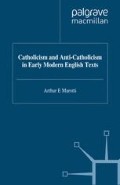Abstract
Anti-Catholic satire dominates the futuristic account of the Paradise of Fools in Book Three of John Milton’s Paradise Lost (1667).1 Located within the sphere of the fixed stars, it is the next stop on Satan’s itinerary after he leaves Hell and passes through Hell Gate (3.430–97). Although many critics have expressed profound regret for the episode ever since the time of Joseph Addison, John Dryden and Alexander Pope pay homage to Milton’s burlesque in their own mock-heroic satires: Mac Flecknoe and The Rape of the Lock.2 Milton adds a polemical twist to the lighter comedy of the flight to the moon undertaken by Astolfo to collect Orlando’s lost wits under the tutelage of St John the Evangelist at Ariosto’s Limbo of Vanity (Orlando furioso, 34. 70–91). Confined to a passing reference to the Donation of Constantine in the Ariostan original, religious satire is such a slight presence that it receives no comment in the annotations on Orlando Furioso in English Heroical Verse (1591) by Sir John Harington. Milton frames the Paradise of Fools very differently.
Access this chapter
Tax calculation will be finalised at checkout
Purchases are for personal use only
Preview
Unable to display preview. Download preview PDF.
Notes
Jaroslav Pelikan, The Melody of Theology: a Philosophical Dictionary ( Cambridge, MA: Harvard University Press, 1988 ), 86–9.
On the proleptic aspect of Limbo, see John Wooten, The Metaphysics of Milton’s Epic Burlesque’, Milton Studies 13 (1979): 256
Marshall Grossman, ’Authors to Themselves’: Milton and the Revelation of History ( Cambridge: Cambridge University Press, 1987 ), 66.
John M. Steadman, Milton and the Renaissance Hero ( Oxford: Clarendon Press, 1967 ), 150.
See John N. King, Tudor Royal Iconography: Literature and Art in an Age of Religious Crisis, Princeton Essays on the Arts (Princeton: Princeton University Press, 1989), fig. 56, 171–2
and Eugene R. Cunnar, ‘Milton’s “Two-Handed Engine”: The Visionary Iconography of Christus in Statera’, Milton Quarterly 17 ( 1983): 29–38.
See Michael Lieb, ‘Milton among the Monks’, in Milton and the Middle Ages, ed. John Mulryan (Lewisburg, PA: Bucknell University Press, 1982 ), 103–14.
Christopher Hill, Milton and the English Revolution, 2nd edn (1977; Harmondsworth: Penguin Books, 1979 ), 421.
Anonymous, Wyclif’s Wicket ( Nuremberg, i.e., London, 1546 )
N. H. Keeble, The Literary Culture of Nonconformity in Later Seventeenth-Century England ( Athens: University of Georgia Press, 1987 ), 268–72.
Norbert Elias, The Civilizing Process: The History of Manners, trans. Edmund Jephcott (New York: Urizen, 1978), 82–3, 130–5. On the ‘oral—anal—sexual imagery’ of Chaos and Limbo
see Michael Lieb, The Dialectics of Creation: Patterns of Birth & Regeneration in Paradise Lost ( Amherst: University of Massachusetts Press, 1970 ), 28–33.
John E. Booty, ed., The Book of Common Prayer 1559: The Elizabethan Prayer Book ( Charlottesville: University Press of Virginia for The Folger Shakespeare Library, 1976 ), 169.
For a catalogue of winds as false inspiration, see Janet Adelman, ‘Creation and the Place of the Poet in Paradise Lost’, in The Author in His Work: Essays on a Problem in Criticism ed. Louis L. Martz, Patricia Meyer Spacks and Aubrey Williams (New Haven: Yale University Press, 1978), 66–7 and n. 9.
The wording may allude further to 2 Peter 2: 1, 18, which attacks ‘false prophets’ who ‘speak swelling words of vanity’. See John C. Ulreich, Jr., ‘“And by Occasion Foretells”: The Prophetic Voice in Lycidas,’ MS 18 (1983): 3–21, p. 7.
Dryden s travesty also alludes to Elisha’s assumption of Elijah’s mantle (2 Kings 2: 9–13). See J. B. Broadbent, Some Graver Subject: an Essay on ‘Paradise Lost’ (: Chatto & Windus, 1960), 263n.
CPW 1: 527; 3: 339. See also Milton’s attack in An Apology against Smectymnuus against ‘mitered hypocrisy’ (1: 924) and instances in other tracts at 1: 590, 679, 894; 3: 195, 545. On acting as a trope for prelatical ’disguising,’ see Jonas A. Barish, The Antitheatrical Prejudice (Berkeley and Los Angeles: University of California Press, 1981), 162.
See Barish, 91, 117, 125, 155; Paul Whitfield White, Theatre and Reformation: Protestantism, Patronage, and Playing in Tudor England ( Cambridge: Cambridge University Press, 1993 ).
On monastic disguise, see Michael Lieb, ‘Milton among the Monks’, in Milton and the Middle Ages, ed. John Mulryan (Lewisburg: Bucknell University Press, 1982 ), 103–14, p. 110
and John N. King, Spenser’s Poetry and the Reformation Tradition (Princeton: Princeton University Press, 1990 ), 50–4, 57.
Giles and Phineas Fletcher, Poetical Works, 2 vols. (Cambridge: Cambridge University Press, 1908–9).
See King, English Reformation Literature, 63, 153–60. Satan’s ‘posing as a cherub’ suggests ‘epistemological perversity’ according to Kenneth Borris, ‘Allegory in Paradise Lost: Satan’s Cosmic Journey’, Milton Studies 26 (1990): 117–18.
See John Guillory, Poetic Authority: Spenser, Milton, and Literary History (New York: Columbia University Press, 1983), 108–13; and King, Spenser’s Poetry 65–79.
The icastic imagination is a ‘peculiar instrument of grace’ according to Paul Stevens, ’Milton and the Icastic Imagination’, Milton Studies 20 (1984): 44.
The aurality of Satanic temptation parodies the priority of hearing the Word versus seeing images in Puritan thought. See Stephen M Fallon, ‘Milton’s Sin and Death: The Ontology of Allegory in Paradise Lost’, ELR 17 (1987): 329–50, p. 341, on Miltonic allegory as an expression of ’fallen epistemology, the perverse refusal of Satan and his devils to acknowledge the unity of a monist universe’. See also Guillory, Authority 148–9.
William Empson, Milton’s God (London: Chatto & Windus, 1961), passim.
Editor information
Editors and Affiliations
Copyright information
© 1999 Palgrave Macmillan, a division of Macmillan Publishers Limited
About this chapter
Cite this chapter
King, J.N. (1999). Milton’s Paradise of Fools: Ecclesiastical Satire in Paradise Lost. In: Marotti, A.F. (eds) Catholicism and Anti-Catholicism in Early Modern English Texts. Early Modern Literature in History. Palgrave Macmillan, London. https://doi.org/10.1057/9780230374881_8
Download citation
DOI: https://doi.org/10.1057/9780230374881_8
Publisher Name: Palgrave Macmillan, London
Print ISBN: 978-1-349-40689-0
Online ISBN: 978-0-230-37488-1
eBook Packages: Palgrave Literature & Performing Arts CollectionLiterature, Cultural and Media Studies (R0)

